Where is the Best Place to Install a Smoke Alarm Detector & Proper Smoke Alarm Locations
If you install a smoke alarm detector in the wrong spot, its response to smoke could be delayed or smoke alarm may not sound an alarm at all.
Knowing where to install smoke alarm detector is as important as having this life saving devices installed at all.
- Where to install smoke alarm detector in a brand new home
- Where to install smoke alarm detector in an existing home
- Locations to avoid smoke alarm detector installation
Watch this short video explaining the basics of where to install smoke alarms in your home and read the article below for more details.
Watch Home Maintenance videos on Youtube.com – Where to Install Smoke Alarms
If you install a smoke alarm detector in a wrong spot, its response to smoke could be delayed or smoke alarm may not sound an alarm at all.
Maintaining of properly installed and functional smoke alarms and detectors is an extremely important part of a home maintenance schedule – keep your family safe!
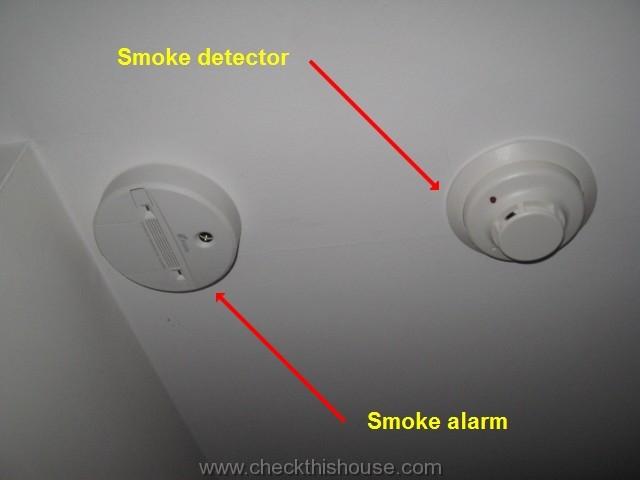 Although a smoke alarm and a smoke detector are two different devices, identical installation / location rules apply to both of them.
Although a smoke alarm and a smoke detector are two different devices, identical installation / location rules apply to both of them.
Smoke alarm detector uses an internal horn to warn occupants of a fire in progress and are either battery powered or hard wired with a battery backup – those are typical devices installed in most homes.
- Smoke detectors are connected and powered by a central fire alarm panel, equipped with a horn (or other notification type device), and often connected to a monitoring station / security system provider, etc. If you have a security system installed, there might be independent smoke alarms in your home, and smoke detectors that are a physical part of this system.
Smoke alarm and smoke detector definitions provided by NFPA (National Fire Protection Association) state that;
- Smoke alarm is “A single or multiple station alarm responsive to smoke.
- Smoke detector is “A device suitable for connection to a circuit that has a sensor that responds to a physical stimulus such as heat or smoke.”
Although, while deciding where to install smoke alarm detector you should always follow device manufacturer’s guidelines, and the NFPA standards (National Fire Protection Association), your local jurisdiction might have a different idea. This idea is usually LESS smoke alarms – Chicago is one of the examples.
Since it is your life we are talking about, following just a minimum requirement is not enough – for literally a few dollars more you can get maximum protection.
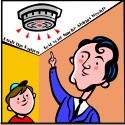 SMOKE ALARM TESTING SCHEDULE
SMOKE ALARM TESTING SCHEDULE
Click on the image (link opens in a new window) and print your smoke alarm testing schedule for the entire year.
Put this smoke alarm testing reminder on your refrigerator, message board… whatever, just remember to do it often! You can involve your kids into the smoke alarm testing and have them mark the schedule every week
Where to install smoke alarm detector?
IRC (International Residential Code), IBC (International Building Code) and NFPA require to install smoke alarm detectors in the following locations:
Where to install smoke alarm detector in a new construction:
The following rules apply in my home-city, Vernon Hills, as well.
- Smoke alarm detector must be hard wired (power supply from the electrical panel) and require battery backup. Your jurisdiction might require a dedicated circuit for this purpose – if such isn’t required, make sure that you don’t install smoke alarm detector on a circuit / tapped to the wall switch controlled ceiling light fixture or outlet receptacle. Attempting to install smoke alarm detector on a GFCI protected electrical circuit also isn’t a good idea. If the circuit protecting GFCI receptacle or breaker trips, your life saving device may stop (in case the battery backup fails as well) providing protection to you and your family.
When you install smoke alarm detector, do not use rechargeable type batteries, good quality alkaline type battery is the right choice. Smoke alarms shall emit a signal when the batteries are low – replace the battery with a new one as soon as you hear that repeating sound.
- Smoke alarm detectors are required in each sleeping area and adjoining hallway area. Like I’ve mentioned before, some jurisdictions require less – Chicago is one of the examples where smoke alarms are not required inside the bedroom / sleeping area.Instead, you have to install smoke alarm within 15’ from the bedroom entrance. In larger homes / apartments, where bedrooms are located more than 30’ apart, two or more smoke detectors might have to be installed.
Vernon Hills requires bedroom smoke alarms to be AFCI (Arc Fault Circuit Interrupter) protected / check the requirements in your jurisdiction
- Install smoke alarm (at least one is required) on each story of the house and in the basement. Crawlspaces and uninhabitable attics do not require a smoke alarm detector installation. However, in case your attic or crawlspace contains a furnace, water heater, or any appliance that could become a source of fire (gas, oil, electric), have a smoke detector installed as well (required by some jurisdictions and highly recommended if not required). If possible, keep at least 20 feet (6 meters) distance to open combustion sources.
- When you install smoke alarm detectors in a new construction, they must be interconnected – one triggered smoke alarm detector activates all of them. Not all types of smoke alarm detectors have the “interconnection” feature, which is extremely important – smoke developing in one section of the house would activate the closest device and automatically all of them at the same time.
Where to install smoke alarm detector in an existing building:
While remodeling, updating of electrical wiring to interconnect existing smoke alarms is not required unless the wall finishes are being removed exposing wall framing. However, even without any rewiring you can still achieve maximum protection by using an interconnected wireless smoke alarm detector system.
- Whenever you install smoke alarm detector it must be positioned in such way that its siren shall be clearly audible in all bedrooms over the background noise levels with all intervening doors closed. That’s why regular testing of the smoke alarm detector siren is so important – just like any mechanical / electronic device – sometimes they fail.
- Enclosed interior staircases also require a smoke alarm detector and one shall be installed on the ceiling of the top floor. Staircases act like chimneys and smoke rising from the lower floor would activate the device giving you an early warning.
Where to install smoke alarm detectors – rules apply to all of the locations described above.
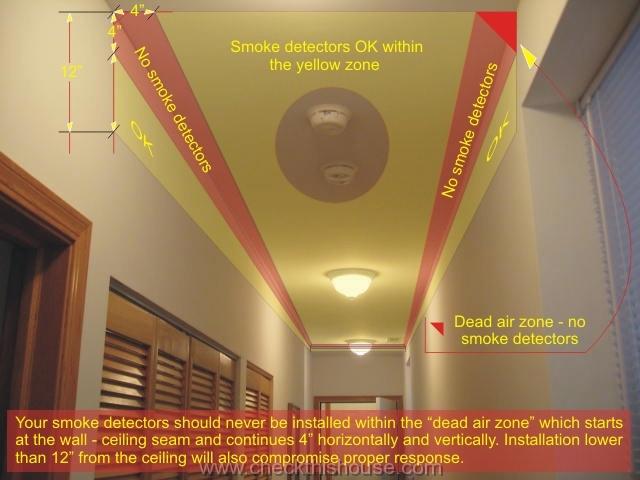
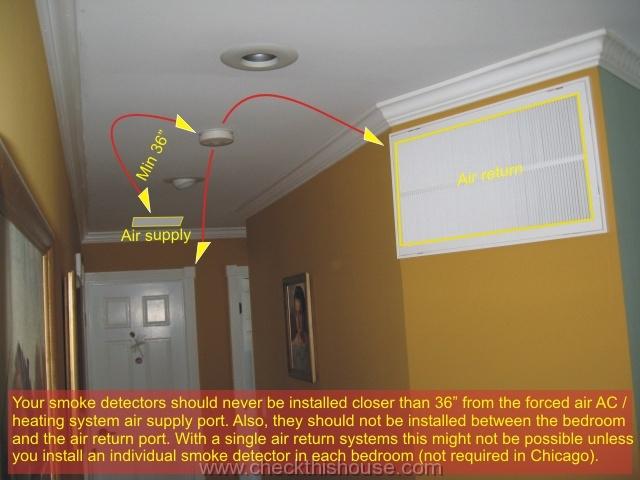
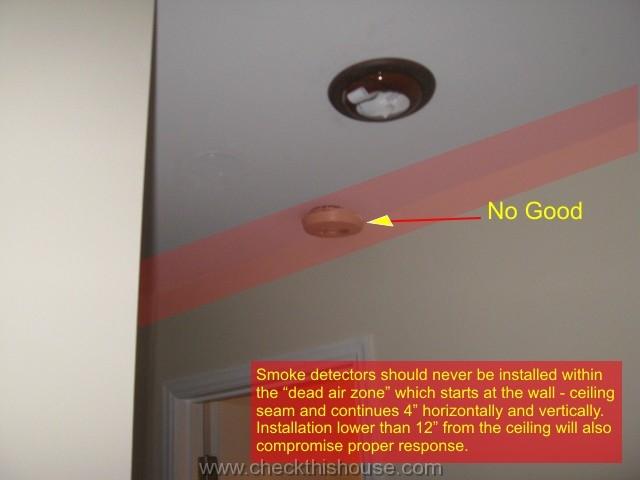
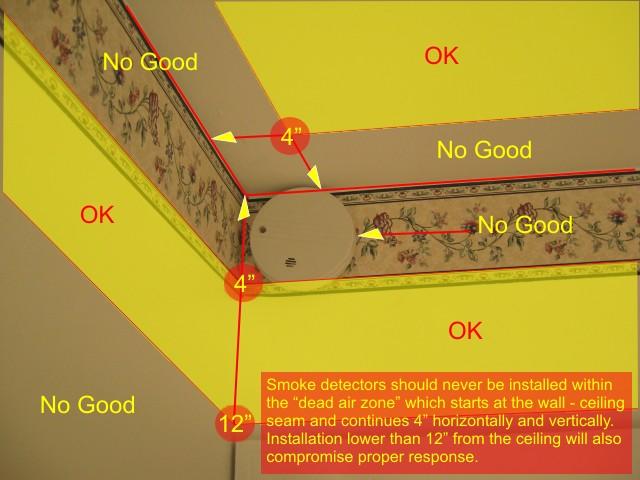 This is extremely important and at the same time quite simple, unfortunately very often done completely wrong. It’s probably because we don’t like to read the manuals and often assume that we know what we’re doing.
This is extremely important and at the same time quite simple, unfortunately very often done completely wrong. It’s probably because we don’t like to read the manuals and often assume that we know what we’re doing.
Before you install smoke alarm detector on the ceiling or wall consider checking the insulation behind that surface. Older homes might be missing a ceiling (if open to the attic) or exterior wall insulation. This would allow extreme heat or cold transfer from exterior into the house, creating a thermal barrier, and prevent smoke from reaching / activating the alarm.
If this is the case (you can simply touch the wall or ceiling during very hot or cold days), install smoke alarm detector on an interior wall of the house.
- To properly install smoke alarm detector on the ceiling (preferable location / might be required in some jurisdictions), place it as close to the center as possible, never closer than 4” (10cm) to the sidewall or corner (check the pictures above).
- If for any reason, ceiling installation is not practical and wall installations are permitted, you can install smoke alarm detectors on the wall with its top edge at a minimum of 4” (10cm) and a maximum of 12” (30.5cm) below the ceiling.
- Install smoke alarm detectors in rooms with cathedral, sloped, peaked, gable ceilings at / or within 3’ from the highest point (measured horizontally).
- Install smoke alarm detectors in each section of the room / area that has been divided by a partial wall. The wall might be coming down from the ceiling (at least 24”) or up from the floor.
- Install smoke alarm detectors on a tray-shaped ceiling (also called coffered ceiling) on the highest portion of the ceiling or on the sloped portion of the ceiling within 12″ (30.5cm) vertically down from the highest point.
Where to install smoke alarm detectors – smoke alarm locations to avoid in order to minimize possibility of false alarms :
1. Do not install smoke alarm detectors in areas where combustion particles are present (Combustion Particles – the by-products of burning process)
- Garages
- Poorly ventilated kitchens
- Close to furnaces and water heaters – recommendation is to keep it at least 20′ away from any open combustion source. I wouldn’t 100% agree with this one, because presence of those particles would be a sign of combustion process problems…
Vernon Hills, IL. requires smoke alarm / detector to be installed in a room containing your furnace and in many cases keeping the 20′ distance may not be possible.
If you decided to install smoke alarm detectors in any of those areas, photoelectric type might be less annoying.
2. Damp or very humid areas such as bathrooms. The humidity levels after taking a hot shower could result in a false alarm.
3. You should not install smoke alarm detectors within 3’ from the forced air heating and / or cooling system air supply vents, in a direct airflow area, close to the whole house fan locations. High air flow could blow smoke or shift it away from the detector preventing it from responding properly or at all.
4. Near fluorescent lights, where electronic “noise” may cause nuisance alarms.
5. Don not install smoke alarm detectors in dusty areas where particles of dust could cause smoke alarm detector failure or false alarm
6. In areas where air temperature may fall below 40°F (4°C) or rise above 100°F (38°C)
7. Do not install smoke alarm detectors in areas near the doors and windows
If you got that far, I hope you have more than a general idea on “where to install smoke alarm detectors” in your home, and what is the optimal smoke alarm detector location, last thing to remember is smoke alarm maintenance.



How far away from furnace to install a smoke alarm?
Hi Irene,
Smoke alarms should be kept at least 20 feet (6 meters) from any sources of open combustion (furnaces, water heaters, fireplaces, kitchen ranges, etc.). If 20 feet distance is not possible (small room size), place it as far as you can to prevent “unwanted” alarms. However, the above smoke alarm distance recommendation would not apply to high efficiency appliances with a sealed combustion chamber that have a combustion air supplied from exterior. This is because the entire combustion process is completely isolated from the house’s interior and combustion particles cannot affect smoke alarm sensor.